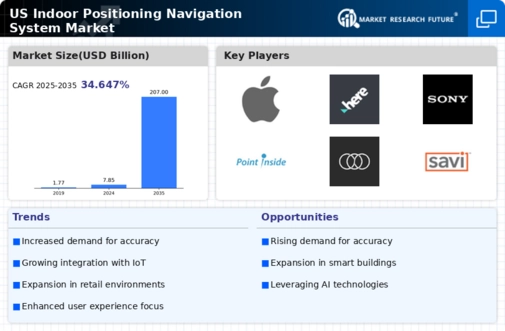The US Indoor Positioning Navigation System Market has witnessed significant advancements and competitive dynamics largely driven by technological innovations and the increasing demand for location-based services. The marketplace is characterized by various players ranging from established tech giants to emerging startups, each vying for dominance through unique positioning technologies, varied service offerings, and strategic collaborations. As industries increasingly recognize the value of accurate indoor navigation for enhancing customer experiences and streamlining operations, the competition has intensified.
Key market drivers include the growing penetration of smartphones, the proliferation of IoT devices, and the demand for enhanced navigation solutions in environments where GPS signals are weak or unavailable. Additionally, the focus on improving user engagement and operational efficiency across sectors such as retail, healthcare, and logistics is shaping the competitive landscape.
Apple holds a significant position in the US Indoor Positioning Navigation System Market, leveraging its ecosystem and technological prowess. The company is well-regarded for its unique approach to indoor navigation, particularly through the use of its ARKit, which facilitates augmented reality applications for indoor positioning. Apple’s integration of various hardware and software capabilities allows for seamless user experiences and intuitive navigation solutions. The company's strengths lie in its robust ecosystem, which includes devices like iPhones and iPads that are widely adopted in the US.
Furthermore, Apple's focus on privacy and user-centric design has strengthened its brand loyalty among consumers, setting it apart from competitors. The continuous investment in research and development enables Apple to enhance its indoor navigation offerings, reflecting a commitment to innovation and customer satisfaction.
HERE Technologies, with its comprehensive location intelligence solutions, also plays a pivotal role in the US Indoor Positioning Navigation System Market. The company specializes in providing highly accurate mapping and positioning services tailored for various applications, including smart cities, logistics, and transportation. HERE Technologies boasts a strong portfolio of key products and services that cater to diverse industries seeking reliable indoor navigation solutions. With strategic partnerships and collaborations, the company has enhanced its market presence by integrating its technologies into various platforms and applications.
Its strengths are underscored by advanced mapping data and analytics capabilities that offer enterprises actionable insights and improved decision-making. Recent mergers and acquisitions have further solidified its position in the market, enabling HERE Technologies to expand its service offerings and enhance its competitive edge, making it a formidable player in the US indoor positioning landscape.
























Leave a Comment